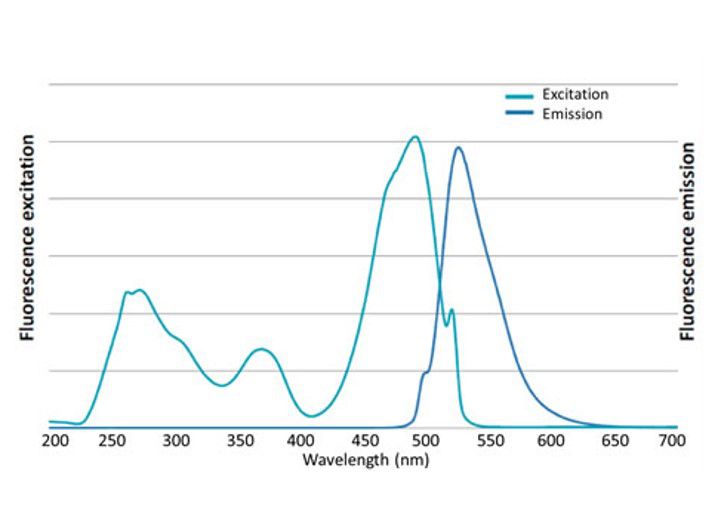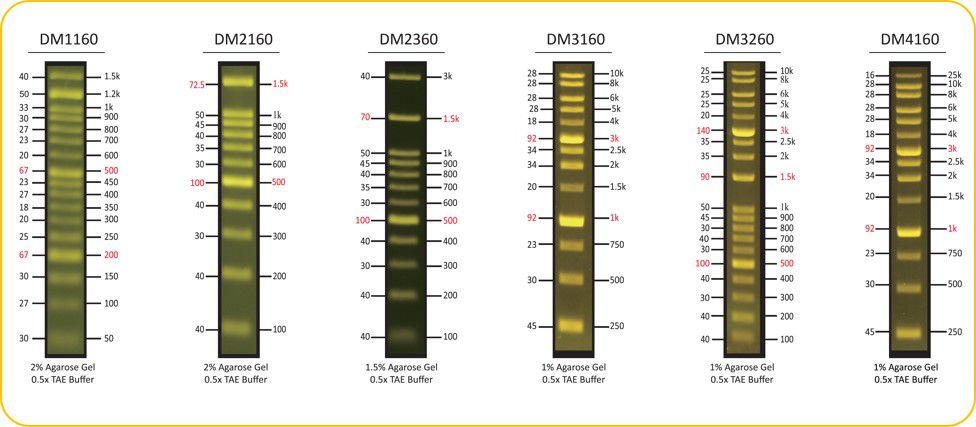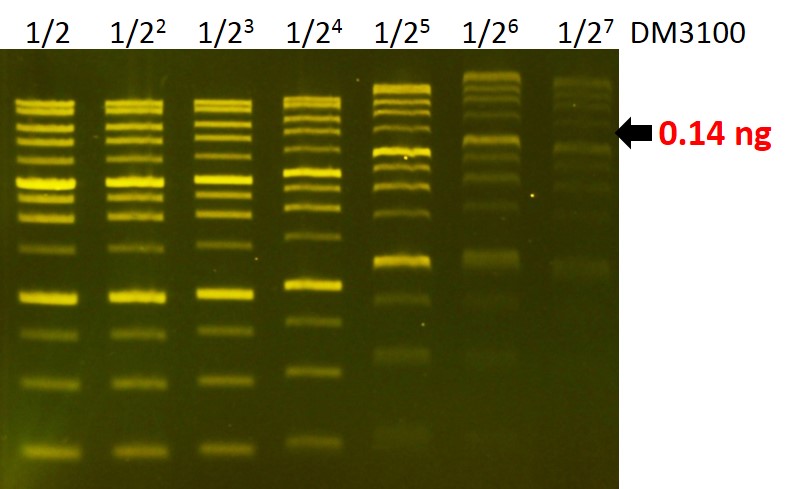Description
FluoroDye™ DNA Fluorescent Loading Dye is a ready-to-use 6X DNA loading dye designed for fast qualitative electrophoresis analysis. Containing sensitive fluorescent dye with high specific affinity towards double stranded DNA (dsDNA), the FluoroDye™ Fluorescent DNA Loading Dye has negligible background and renders destaining process unnecessary. The FluoroDye™ DNA Fluorescent Loading Dye allows the user to immediately visualize electrophoresis result upon completion or to monitor the electrophoresis in real time. FluoroDye™ DNA Fluorescent Loading Dye is compatible with both the conventional UV gel-illuminating system as well as the less harmful long wavelength blue light illumination system. FluoroDye™ emission as bound to dsDNA is 522 nm, while its excitation peaks are at 270, 370 and 497 nm.
Features:
Excellent for premix with DNA samples
Sensitivity: 0.14 ng (DNA)
A safer alternative to EtBr
Compatibility: suitable to blue or UV light
Increased cloning efficiency (blue light)
Composition
FluoroDye™ DNA Fluorescent Loading Dye is stored in 6X concentration in 60% glycerol and buffered with Tris-HCl and EDTA, containing Bromophenol blue, Xylene cyanol FF and Orange G as tracking dyes.
Storage
Protected from light
-20°C for 24 months

Sensitivity of FluoroDye™
FluoroDye™ DNA Fluorescent Loading Dye (DL5000) shows a green-yellow fluorescence under blue light excitation. The sensitivity of DL5000 is about 0.14 ng (arrow) for a 4 kb fragment.

Excitation and emission spectrum of FluoroDye™
FluoroDye™ DNA Fluorescent Loading Dye (DL5000) emission as bound to dsDNA is 522 nm while its excitation peaks are at 270, 370 and 497 nm.
Contents
|
Component |
Volume |
Cat. No. |
|
FluoroDye™ DNA Fluorescent Loading Dye (Green, 6X) |
1 ml |
DL5000 |
|
FluoroDye™ DNA Fluorescent Loading Dye (Green, 6X) |
1 ml x 5 |
DL5001 |
Storage
Protected from light
-20°C for 24 months
Will FluoroDye™ DNA Fluorescent Loading Dye (DL5000) affect the DNA samples in subsequent experiments?
Using FluoroDye™ DNA Fluorescent Loading Dye (DL5000) does not affect subsequent operations. This is because the fluorescent dye can easily be removed by regular alcohol precipitation or gel elution kits.
Will the FluoroDye™ DNA Fluorescent Loading Dye (DL5000) affect cloning efficiency?
Using the fluorescent dye coupled with blue light, the cloning efficiency is increased by about 100 times compared to using EtBr and UV light.
Can the FluoroDye™ DNA Fluorescent Loading Dye (DL5000) be removed from DNA? How can we do it?
The staining dye can be removed from DNA with traditional ethanol precipitation, PCR clean up kits, or the gel extraction kits. The ethanol precipitation method can follow conventional molecular cloning or follow the listed protocol. Ethanol precipitation.
A. Measure the volume of the DNA sample.
B. Add 1/10 volume of 3M sodium acetate, pH 5.2,(final concentration of 0.3 M) - The pH value of 3M sodium acetate must be adjusted with acetate not with HCl.
C. Mix well.
D. Add 2 to 2.5 volumes of cold 100% ethanol (calculated after salt addition).
E. Mix well.
F. Place on ice or at -20 °C for >20 minutes.
G. Spin at maximum speed in a microfuge for 10-15 min.
H. Carefully decant supernatant.
I. Add 1 mL 70% ethanol. Rinse and spin briefly. Carefully decant supernatant.
J. Air dry or briefly vacuum dry pellet.
K. Re-suspend pellet in the appropriate volume of TE, Tris buffer or water.
Can the FluoroDye™ DNA Fluorescent Loading Dye (DL5000) stained DNA be used for enzymatic reaction like ligation, enzyme digestion, PCR and so on? Do you have any recommended methods like pretreatment?
After removing the fluorescent staining dye from DNA, the DNA can be used for ligation, restriction enzyme digestion or PCR reaction. It is imperative that the DNA is maintained in good quality for bioassay after removing the stained dye. We recommend removing the fluorescent staining dye with the gel extraction kits or PCR clean up kits because these methods are convenient and high efficiency. The very low amount of fluorescent staining dye does not affect ligation, enzyme digestion or PCR. However, the threshold is related to the enzyme systems and it is on a case-by-case basis. For the best results, we recommend to remove the fluorescent staining dye from DNA before proceeding to the next step of the experiment.
As the FluoroDye™ DNA Fluorescent Loading Dye (DL5000) is used, is the migration of DNA affected by the fluorescent dye?
Yes, it might be affected due to variation of DNA amount mixed with the fluorescent loading dye. The fluorescence composition in a fluorescent loading dye is fixed, so for different amounts of DNA different degrees of binding to fluorescent dyes are expected. Variety in DNA/fluorescence ratio might lead to variation in DNA migration; the higher the fluorescence ratio is, the slower the DNA fragments migrate. In general, a DNA amount of ≥31.25 ng with 1 μL DL5000 loading dye will be an acceptable range. If the DNA concentration is lower than 31.25 ng, the molecular weight determination may be slightly distorted. For analyzing DNA sample of unknown concentration, it is recommended to use the FluoroStain™ DNA staining dye with post-staining method or to use FluoroVue™ nucleic acid staining dye with in-gel staining method.
Elham Taheri Bajgan, Ali Zahedmehr, Farshad Shakerian, Majid Maleki, Hooman Bakhshandeh, Seyed Javad Mowla, Mahshid Malakootian
Sci Rep. 2024; 14: 1244. Published online 2024 Jan 13. doi: 10.1038/s41598-024-51715-2
PMCID: PMC10787829
Appressoria-Producing Sordariomycetes Taxa Associated with Jasminum Species
Deecksha Gomdola, Eric H. C. McKenzie, Kevin D. Hyde, Digvijayini Bundhun, Ruvishika S. Jayawardena
Pathogens. 2023 Dec; 12(12): 1407. Published online 2023 Nov 29. doi: 10.3390/pathogens12121407
PMCID: PMC10745922
Additions to Diatrypaceae (Xylariales): Novel Taxa and New Host Associations
Naghmeh Afshari, Omid Karimi, Antonio R. Gomes de Farias, Nakarin Suwannarach, Chitrabhanu S. Bhunjun, Xiang-Yu Zeng, Saisamorn Lumyong
J Fungi (Basel) 2023 Dec; 9(12): 1151. Published online 2023 Nov 28. doi: 10.3390/jof9121151
PMCID: PMC10744582
Pattarana Sae-Chew, Thidarat Rujirawat, Yothin Kumsang,a Penpan Payattikul, Tassanee Lohnoo, Wanta Yingyong, Chalisa Jaturapaktrarak, Tiwa Rotchanapreeda, Onrapak Reamtong, Tanawut Srisuk, Weerayuth Kittichotirat, and Theerapong Krajaejun. mSystems. 2020 May-Jun; 5(3): e00196-20. Published online 2020 May 12. doi: 10.1128/mSystems.00196-20
PMCID: PMC7219551
PCR analysis for assessment of bacterial bioburden in orthokeratology lens cases
Jung Lo, Po-Chiung Fang, Chun-Chih Chien, Chang-Chun Hsiao, Shin-Ling Tseng, Yu-Hsuan Lai, Ming-Tse Kuo Mol Vis. 2016; 22: 1–8. Published online 2016 Jan 14. PMCID: PMC4734148
Ramezan Ali Ataee, Ali Mehrabi-Tavana, Seyed Mohammad Javad Hosseini, Farshad Kaviani Iran J Microbiol. 2016 Jun; 8(3): 203–209.
PMCID: PMC5139924
Chung-Che Tsai, Ting-Yu Kuo, Zhi-Wei Hong, Ying-Chieh Yeh, Kuo-Shun Shih, Shin-Yi Du, Hua-Wen Fu Virulence. 2015 Nov-Dec; 6(8): 755–765. Published online 2015 Sep 16. doi: 10.1080/21505594.2015.1043505
PMCID: PMC4826132

B-BOX™ Blue Light LED Epi-illuminator
470 nm long wavelength
Improved cloning efficiency
Compact, light-weight, and portable (less than 1 kg)
Adjustable and removable filter plate allows for gel cutting, visualization, and documentation
470 nm long wavelength
Improved cloning efficiency
Compact, light-weight, and portable (less than 1 kg)
Adjustable and removable filter plate allows for gel cutting, visualization, and documentation

FluoroBand™ DNA Ladder series
Sharp bands
Quick reference— enhanced bands
Ready-to-use— premixed with loading dye for direct loading
Stable— room temperature storage over 6 months
Directly observed by UV or blue light— premixed with high sensitive fluorescent dye

FluoroVue™ Nucleic Acid Gel Stain
Excellent for in-gel staining
Sensitivity up to 0.14 ng (DNA) or or 1 ng (total RNA)
A safe alternative to EtBr
Suitable for blue or UV light
Excellent for in-gel staining
Sensitivity up to 0.14 ng (DNA) or or 1 ng (total RNA)
A safe alternative to EtBr
Suitable for blue or UV light

![[DL5000] FluoroDye™ DNA Fluorescent Loading Dye (Green, 6X), 1 ml](/web/image/product.template/331/image?unique=9b2f24a)


![[DL5000] FluoroDye™ DNA Fluorescent Loading Dye (Green, 6X), 1 ml](/website/image/product.template/331/image/90x90)

